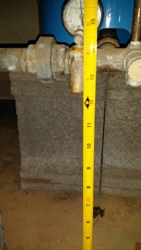What our Clients’ Say
Gary,
Thanks again for your diligence yesterday in being very thorough with Meg and I. We very much appreciate this and its' been a great experience working with you. I'm glad I called. I also passed this information onto Ellen and told her this was the best inspection experience I've had.
Oz
Thanks for the great job you did Gary. I appreciated your thorough work and detailed report, as well as suggestions for improvements.
— Brett T.
Our Services Include
- Buyer or seller home inspections
- Well and septic system inspections
- Radon testing
- Water testing
- Mobile home foundation certifications
- Construction draw inspections
Our Company Brochure
Prepare your property for Home Inspection
Allow exclusive access for buyers during the inspection for the time that has been requested and approved.
Please have these areas or items accessible.
- Attic access doors. If nailed or screwed in place please remove fasteners, often in areas used for storage, like closets, or above appliances. Remove items that may prevent access or can get dirty or damaged if left in place. The inspector will need room to place a ladder for any overhead access doors.
- Electrical panels: The inspector will want to remove the panel covers. All screws holding the cover need to be removed to inspect the electrical panel.
- Furnace/ boilers/fireplaces/wood stoves: The inspector will want to remove furnace covers and have a full view of all heating appliances.
- Water heaters: The inspector will want to have a full view of the water heater.
- Windows, open all drapes or shades: The inspector wants access to all windows.
- Garage doors: Remove vehicles and storage so the doors can be operated.
- Crawlspaces access doors: If nailed or screwed in place remove fasteners, remove all storage from the area. Access doors are often in floors of closets, but may be under furniture or appliances.
- Take your pets with you or put them in a kennel. The inspector will not be responsible for pet safety. Home inspections require the inspector to go in and out of the home frequently. If you have to leave the animal on the property during the home inspection kennel the animal so it cannot escape.
For well and septic system inspections.
- If the septic tank covers are concealed by anything remove it (dirt, planters, flowers, birdbaths, statues, fake rocks, etc )
- Once exposed leave the covers in place. Un-lock any locks
- Don't pump septic tanks while your home is listed for sale unless you are having problems
- Septic Inspector Gary Roholt prefers that septic tanks be pumped at the time of inspection so the interior components of the tank can be inspected. The septic pumper should not pump your septic tank prior to the inspectors arrival. Recent changes to Addendum B puts the responsibility on the buyers of the property unless the sellers agree otherwise. If you agree to pay the pumper bill the septic inspector will provide the pumpers information so you know what it will cost for pumping. Septic inspector Gary Roholt has knowledge of most pumpers in the region. Some do not want to schedule a time to meet during the inspection. We will refer you to those we know of that will
- Wells; mark the location if concealed, especially in winter
- Remove items that you may be using to conceal your Well (dirt, planters, flowers, birdbaths, statues, fake rocks)
- Remove storage around the well pressure tank.
- Well sampling faucet should be 12 inches above the floor, spigot directed to the floor, and not have threads. Fix this prior to the well inspection to avoid lender issues with code compliance.


Septic System Note: To properly complete a septic inspection/test requires opening the septic tank(s). The purpose of pumping at the time of inspection is to have access to observe components in the tank/s, not because it is due for pumping. Recent pumping does not mean it does not need to be pumped again in order to properly complete the inspection. If the cover is buried and the owners pumper will not dig, the cover should be exposed by others prior to the time of the inspection. Owner should mark the location of the septic tank cover for digging if septic pumper will dig. Buried septic tank covers are approximately 24- 30 inches in diameter made of concrete, plastic, or steel. Owners often conceal the tank cover with dirt and plant flowers, bushes, cover with large objects , decks, or concrete walkways. These objects would need to be moved to get the cover(s) exposed. The inspector will not be held responsible for damage to flower beds, bushes, trees, or any other object used to conceal the septic tank cover if they are not moved prior to the inspection. The septic pumping contractors need to be told it is for an inspection so they do not pump prior to the Inspectors arrival. If the seller does not know where the septic system is please let us know in advance we may need to arrange for additional resources per Addendum B,” Different professionals may be needed”. If you have any Questions about Addendum B language please do not call the Inspector you need to contact your Real Estate Broker or Attorney for clarification.
We serve Rice Lake, Eau Claire, Chippewa Falls, Hayward, Spooner, Bloomer, Ladysmith, Cumberland, Menomonie and Cable






